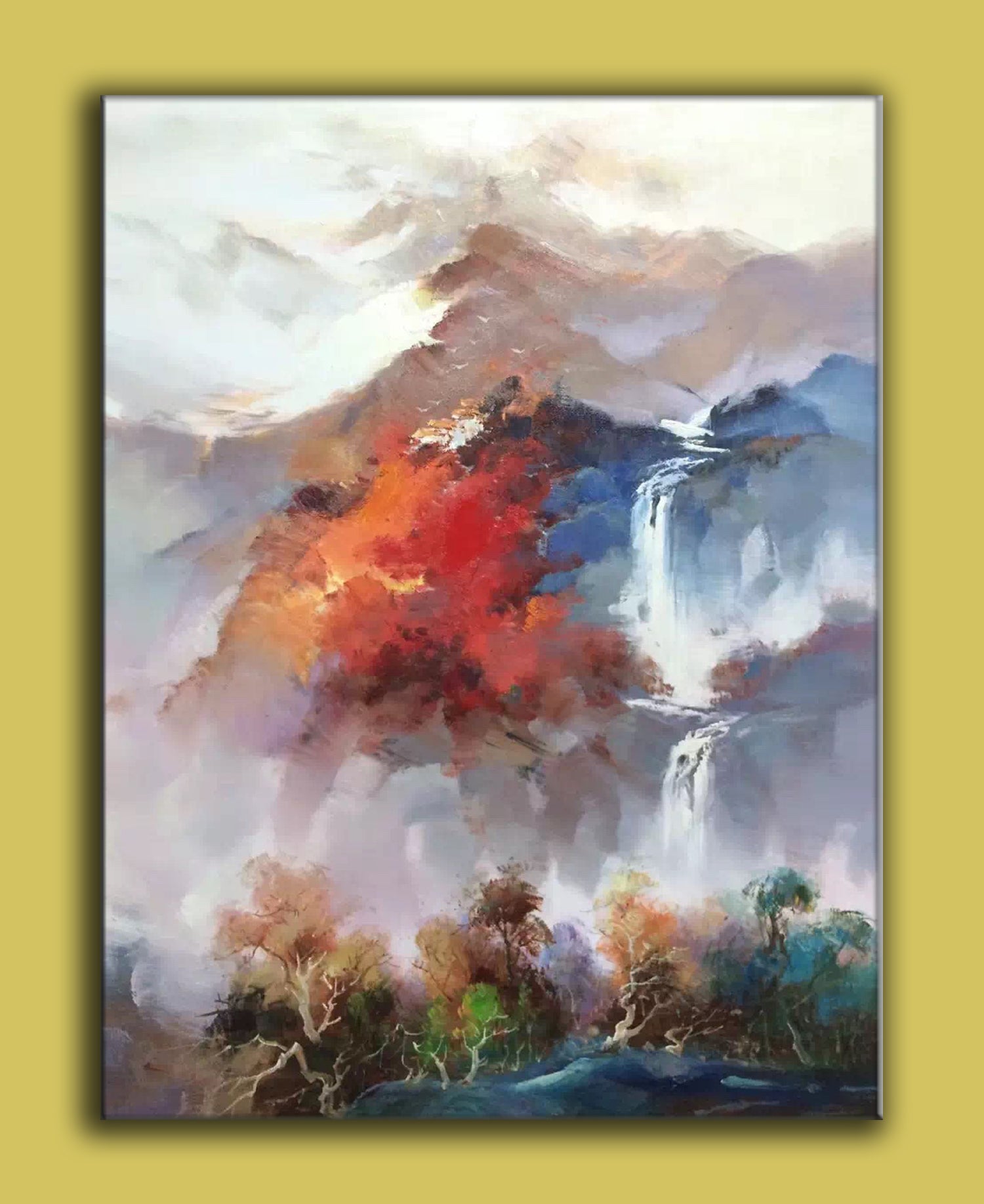The Benefits of Buying Oil Paintings: Why They Are a Timeless Investment
The advantages of purchasing oil paints prolong past plain looks. These art work carry historical significance and social value, making them worthwhile additions to any type of collection. Their distinct structures and techniques add to an appealing aesthetic experience. Well-known artists typically see their work value over time, offering a potential monetary advantage. As one explores the complex factors for purchasing oil paints, the much deeper implications of such a selection become significantly noticeable
The Visual Allure of Oil Paints
The appeal of oil paintings lies in their abundant appearances and lively colors, which can transform any area right into a fascinating atmosphere. These artworks have a depth that mesmerizes audiences, attracting them into the details of the brushstrokes and the interaction of light and shadow. The shiny surface of oil paint improves the aesthetic experience, enlivening scenes and subjects in a manner that other tools often can not accomplish. Furthermore, the selection of designs-- from classic to modern-- permits a diverse selection that can match any design. The emotional vibration communicated through color selections and techniques includes a layer of link between the observer and the artwork, making oil paints not just decorative products, but powerful expressions of creative vision.
Historical Importance and Social Value
Oil paints work as necessary links to an imaginative heritage, showcasing techniques and styles that have developed over centuries. They envelop cultural expressions and identities, mirroring the values and narratives of their time. By getting these works, individuals contribute to the conservation of background and the admiration of diverse cultural legacies.
Creative Heritage Preservation
While numerous might ignore the significance of imaginative heritage, buying oil paints plays an important duty in maintaining social and historic stories. These artworks work as visual documents of their time, capturing the essence of social worths, practices, and historical events. By obtaining oil paints, collection agencies add to the safeguarding of cultural legacies, making certain that future generations can value and find out from these imaginative expressions. Each item reflects the unique story of its maker and the context in which it was made. In addition, the ongoing admiration and display screen of oil paints in different setups assist to cultivate an understanding of varied imaginative movements, enhancing the cultural landscape. Therefore, purchasing oil paints is not simply an economic choice however an act of cultural stewardship.
Cultural Expression and Identification
Art functions as a powerful medium for social expression and identification, reflecting the diverse stories that shape cultures. Oil paintings, specifically, record the significance of social heritage, illustrating sociopolitical environments and historic contexts. Each brushstroke communicates tales and feelings one-of-a-kind to particular customs, permitting customers to involve with the musician's cultural background. This link cultivates a feeling of belonging and recognizing amongst various areas. Furthermore, oil paints frequently act as aesthetic paperwork of cultural evolution, showcasing changes in identity over time. The investment in these artworks not just sustains artists however likewise protects social traditions, making them significant assets for collectors. Inevitably, oil paints improve one's appreciation for the intricacies of human experience and the rich tapestry of social identification.
Appreciation in Worth In Time

The admiration of oil paints in time is affected by various variables, consisting of historic worth fads that reflect altering preferences and cultural significance. In addition, the credibility of the artist plays an essential role in determining the art work's market price, frequently boosting as the musician gains acknowledgment. Market need variations can better impact prices, making oil paints a possibly lucrative investment for collectors.
Historic Worth Fads
As collectors look for to purchase concrete properties, the historic value trends of oil paints reveal a compelling narrative of recognition over time. Historically, oil paints have shown a regular upward trajectory in value, specifically for jobs by established artists. Economic cycles and market demand have influenced these trends, with periods of enhanced interest usually causing substantial cost surges. Auction documents frequently highlight the remarkable returns achieved by iconic pieces, even more reinforcing the idea of oil paints as viable long-lasting financial investments. In addition, cultural movements and changes in enthusiast preferences have periodically stimulated unexpected appreciation, revealing that the art market, while somewhat uncertain, typically favors quality oil paints. Subsequently, comprehending these historical patterns can direct investors in making educated decisions.
Musician Credibility Influence
While the credibility of a musician plays a vital role in the appreciation of oil paints, it is very important to identify that this impact can vary substantially based on several aspects. Established musicians, particularly those with a considerable historical or social influence, have a tendency to see their works appreciate much more rapidly. On the other hand, lesser-known or emerging artists may not experience the exact same level of demand, affecting their artwork's worth. Additionally, the musician's capacity to develop a regular body of work and keep significance in the art globe can affect lasting gratitude. Enthusiasts typically look for works from musicians who are acknowledged by trustworthy galleries and organizations, which can additionally enhance the worth of an oil paint with time, making artist credibility a crucial factor to consider in financial investment choices.

Market Need Fluctuations
Exactly how do market need fluctuations affect the gratitude of oil paints over time? The worth of oil paintings is inherently linked to market demand, which can differ based upon financial conditions, trends, and collection agencies' choices. In times of financial success, demand commonly climbs, bring about raised costs as even more customers get in the market. On the other hand, throughout economic declines, need might decrease, triggering values to stagnate or perhaps decline. In addition, the popularity of certain artists can shift, impacting their work's worth. Inevitably, understanding market demand is vital for capitalists, as well-managed collections can appreciate substantially in time, showing both the skill of the musician and the broader market dynamics. This interplay highlights the relevance of tactical getting in oil painting financial investments.
Special Textures and Methods
Oil paints mesmerize customers with their unique structures and techniques, showcasing the musician's proficiency over the medium. The thick application of paint, referred to as impasto, creates a three-dimensional result, welcoming touch and boosting aesthetic depth. Musicians commonly use various brush strokes, layering, and glazing approaches to accomplish detailed information and luminescent colors. This flexibility permits for rich contrasts and subtle shifts, making each artwork uniquely expressive. The sluggish drying time of oil paint makes it possible for musicians to mix colors seamlessly, resulting in smooth slopes and lively tones. These methods add to the paint's general character, making it an engaging centerpiece. Each oil painting functions as an indicator of the creativity and skill intrinsic in conventional artistic methods.
Adaptability in Home Decor
The special textures and methods of oil paintings not just display artistic skill yet additionally improve their flexibility in home style. These art work can seamlessly enhance numerous interior styles, from modern minimalist to standard style. click here Oil paintings offer as prime focus, drawing focus and sparking discussion amongst guests. Their rich colors and depth can balance with different color combinations, making them versatile to changing style patterns. Additionally, the psychological vibration of oil paintings can create atmosphere, whether it be heat in a cozy living space or vibrancy in an imaginative work area. By integrating oil paints, home owners boost their rooms, transforming them into thoughtfully curated settings that reflect personal preference and artistic gratitude. Eventually, oil paintings are an enduring option for improving home appearances.
Link to Prominent Musicians
While lots of art kinds can stimulate appreciation, buying oil paintings typically establishes an unique link to prominent musicians throughout history. Possessing an oil paint enables collection agencies to engage with the innovative visions of masters like Van Gogh, Monet, and Rembrandt. Each brushstroke symbolizes the musician's purposes, feelings, and strategies, using insight into their globe. This connection transcends time, as each piece lugs a story that shows the historic and social context of its development. Enthusiasts not just acquire a work of art but also a fragment of the artist's heritage. As art enthusiasts check out the stories behind these paints, they get a much deeper gratitude for the workmanship and creative movements that shaped their growth, boosting the value of their investment.
Psychological and Emotional Advantages of Art
Art frequently works as a powerful stimulant for mental and psychological wellness. The visibility of oil paints in a living room can evoke a series of feelings, from harmony to inspiration. Their elaborate information and vivid colors supply viewers a getaway, permitting representation and consideration. Studies recommend that engaging with art can lower tension and anxiousness, promoting a sense of calmness. In addition, owning initial artwork can create an individual link, enhancing sensations of pride and pleasure. This emotional bond usually leads to a deeper admiration of one's surroundings, transforming a home right into a home. Eventually, the psychological benefits of art extend beyond visual appeals, adding to general mental health and wellness and improving life experiences.

Frequently Asked Concerns
Exactly how Do I Select the Right Oil Paint for My Room?
Picking the right oil paint involves considering the area's shade system, dimension, and general visual. One need to evaluate personal preference, the painting's psychological impact, and just how well it complements existing decoration before choosing.

What Factors Influence the Value of an Oil Painting?
The worth of an oil painting is affected by aspects such as the artist's reputation, provenance, historical significance, condition, rarity, and market demand. Each component adds to overall worth and worth among collectors.
Exactly How Can I Care for and Preserve My Oil Paint?
To take care of and keep an oil paint, one ought to on a regular basis dust it with a soft fabric, avoid straight sunlight exposure, control humidity levels, and think about expert cleansing to protect its vibrancy and integrity.
Exist Details Musicians Recognized for Their Oil Paints?
Many musicians are renowned for their oil paints - oil paintings for sale. Remarkable figures include Vincent van Gogh, Claude Monet, and Rembrandt, each celebrated for their unique strategies and payments to the art world through dynamic, textured oil tools
Where Can I Acquisition Authentic Oil Paintings?
Genuine oil paints can be purchased from trustworthy galleries, art fairs, and on-line systems focusing on art. Collection agencies need to validate the authenticity and provenance before buying to assure a useful financial investment. Historically, oil paints have actually demonstrated a constant higher trajectory in worth, specifically for jobs by well established artists. While the credibility of a musician plays an essential role in the gratitude of oil paintings, it is essential to acknowledge that this influence can differ considerably based on a number of factors. Oil paintings captivate audiences with their unique structures and techniques, showcasing the musician's proficiency over the tool. While lots of art kinds can stimulate admiration, acquiring oil paints usually develops an one-of-a-kind connection to renowned musicians throughout history. The worth of an oil painting is affected by elements such as the musician's credibility, provenance, historic significance, market, rarity, and problem need.